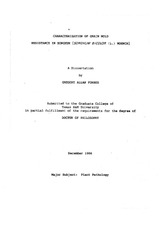| dc.description.abstract | Sorghum grain lots with various levels of resistance to sorghum grain mold (SGM) were evaluated for several loss parameters: kernel weight, kernel density, electrolyte leachate level, percentage germination, vigor, and visual quality appraisal; and two indirect measures of disease intensity, ergosterol level and colonyforming units (CFU) of Fusarium moniliforme. Ergosterol level was
significantly correlated with CFU (r= +0.94), visual rating (r= +0.92), leachate level (r= +0.90), and percentage germination (r= -0.86). Leachate level was highly correlated with germination (r= -0.98). In all cases, correlation coefficients for the standard deviation of kernel weight were higher than for the mean. Fitting variables to a theoretical linear model resulted in a highly significant cultivar x treatment (treatment = inoculated vs. noninoculated) interaction for kernel weight.
Two greenhouse inoculation procedures, vacuum infiltration and panicle spraying differented among resistant and susceptible cultivars and caused symptoms similar to those resulting from natural infection or inoculation in the field. On susceptible cultivar TX2536, reduction in kernel weight due to inoculation by the vacuum and panicle spray methods were 31 and 41%, respectively, and reductions in percentage germination were 93 and 94%, respectively. On resistant cultivar SC0170-6, kernel weight reductions for vacuum and spray inoculations were 10 and 22%, respectively.
Paraffin- and resin-embedded spikelets of a susceptible and resistant cultivar were inoculated with Fusarium moniliforme and examined for differences in the invasive processes that may be related to resistance. Glumes, lemma, palea, and stamens were intra- and intercellularly colonized in TX2536, but not in SC0170-6. Necrosis and extracellular epidermal deposition characterized host response to the pathogen in SC0170-6. Necrosis appeared subsequent to colonization in TX2536.
SGM had a greater effect on phenolic compounds than on total phenolic acids (PA). Disease caused some PA (e.g., p-coumaric and gallic) to increase more in resistant cultivars than in suscepts. One unidentified compound increased as a result of disease in spikelets of suscept TX2536 and decreased in tissues of resistant cultivar SC0103-12. | en |


